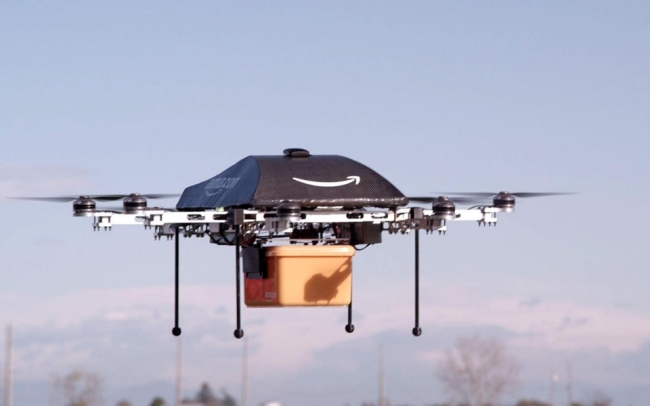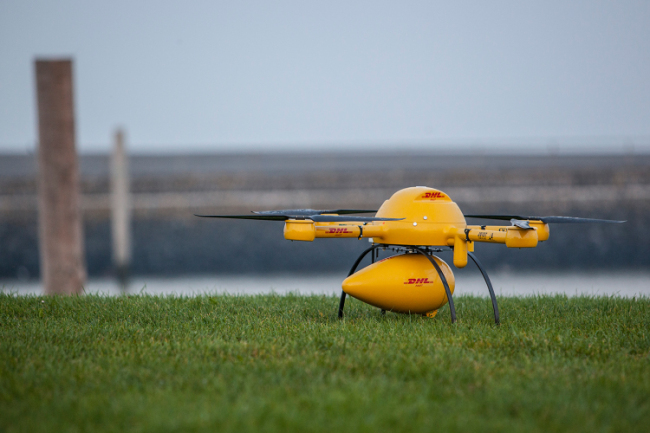Koreans are known for their impatient temperament and cutting-edge innovations, but not even Korea has developed the idea of deliveries to your door by drone.
That is the crux of U.S. retail giant Amazon’s Prime Air 30 Minute Delivery service, which was first unveiled in December 2013.
Amazon plans to deliver packages weighing less than 2.2 kg to anywhere within 16 km of a servicing warehouse in less than half an hour.
The hurdle is not that the technology is in the realm of science fiction ― it isn’t ― but the regulatory problems of implementing the forward-looking program.
That is the crux of U.S. retail giant Amazon’s Prime Air 30 Minute Delivery service, which was first unveiled in December 2013.
Amazon plans to deliver packages weighing less than 2.2 kg to anywhere within 16 km of a servicing warehouse in less than half an hour.
The hurdle is not that the technology is in the realm of science fiction ― it isn’t ― but the regulatory problems of implementing the forward-looking program.

“The hardest challenge in making this happen is going to be demonstrating to the standards of the (Federal Aviation Administration) that this is a safe thing to do,” said Amazon CEO Jeff Bezos upon revealing his drone-delivery plan. Months later, he said in a televised interview, “The long pull’s going to be regulatory.”
Though patented by Amazon in May, Google has also been testing its own Project Wing drone-delivery program in Australia, to avoid similar regulatory complications.
German delivery firm DHL already launched Europe’s first commercial drone delivery service. It made its first delivery ― medical supplies to a German island 12 km north of the mainland ― in under 15 minutes last September.
The company’s “parcelcopter” service is only an extension of Europe’s already open stance toward commercial drones.
French energy company GDF Suez has been using a civilian drone company to monitor its natural gas infrastructure for “preventive maintenance” since last April. A French wine council has been using drones to detect vine diseases since last November.

Drones have already long been in use in military operations, humanitarian crises ― the earthquakes in Nepal are one example ― and, more recently, by hobbyists. Yet as businesses catch on to the industrial potential of the unmanned flying devices, they are being held in check by regulators.
The key concern is that drones, which can easily weigh over 10 kg and fly up to 100 kph, can collide and cause fatal accidents. Drones are also difficult to track with radar coverage, as they fly at low altitudes of under 150 meters ― as recently demonstrated by mysterious drone sightings in Paris earlier in May.
In the U.S., NASA is reportedly collaborating with Verizon, the country’s largest provider of wireless communications, to develop monitoring systems for civilian drones by 2019.
But until then, U.S. aviation regulators are insisting that while tech giants like Amazon are allowed to “experiment” with drones, the drones must “always remain within the visual line of sight of the (licensed) pilot and observer,“ which drastically limits its operational scope.
In the wrong hands, drones can also infringe on civilians’ privacy, as already demonstrated by paparazzi, particularly as they are not yet specifically subject to personal information protection laws.
“You have any idea how much fun we could have with this thing? We could spy on everyone!” said Cartman in a telling “South Park” episode last October that highlighted voyeuristic tendencies among some drone enthusiasts.
A staff member at DJI, one of the world’s most iconic drone-makers, said last year, “We’re looking forward to a lot clearer rules in the U.S. and several other countries,” while touting its recreational benefits.
The European Aviation Safety Agency is seeking to update its “fragmented regulatory framework” with additional standards that cover safety, security, privacy, data protection, insurance and liability, even as it enthuses about the “promising industry” for drones.
“Our priority is not just to develop regulations, but to make sure the regulations do not strangle this new and upcoming industry,” said EASA spokesperson Ilias Maragakis, as cited by U.S. media.
There is much to be excited about ― scientists are already seeing a cost-effective use for drones, equipped with HD cameras and motion triggers, to explore active volcanoes and other dangerous sites too costly for human expedition.
For the moment, drones remain unauthorized for widespread commercial use in most countries ― but before long, the pilotless aircraft may soon change the face of global businesses, industries and our skies.
By Yoon Sarah (sarah356@heraldcorp.com)
-
Articles by Korea Herald




![[Herald Interview] 'Amid aging population, Korea to invite more young professionals from overseas'](http://res.heraldm.com/phpwas/restmb_idxmake.php?idx=644&simg=/content/image/2024/04/24/20240424050844_0.jpg&u=20240424200058)












![[KH Explains] Korean shipbuilding stocks rally: Real growth or bubble?](http://res.heraldm.com/phpwas/restmb_idxmake.php?idx=652&simg=/content/image/2024/04/25/20240425050656_0.jpg&u=)

